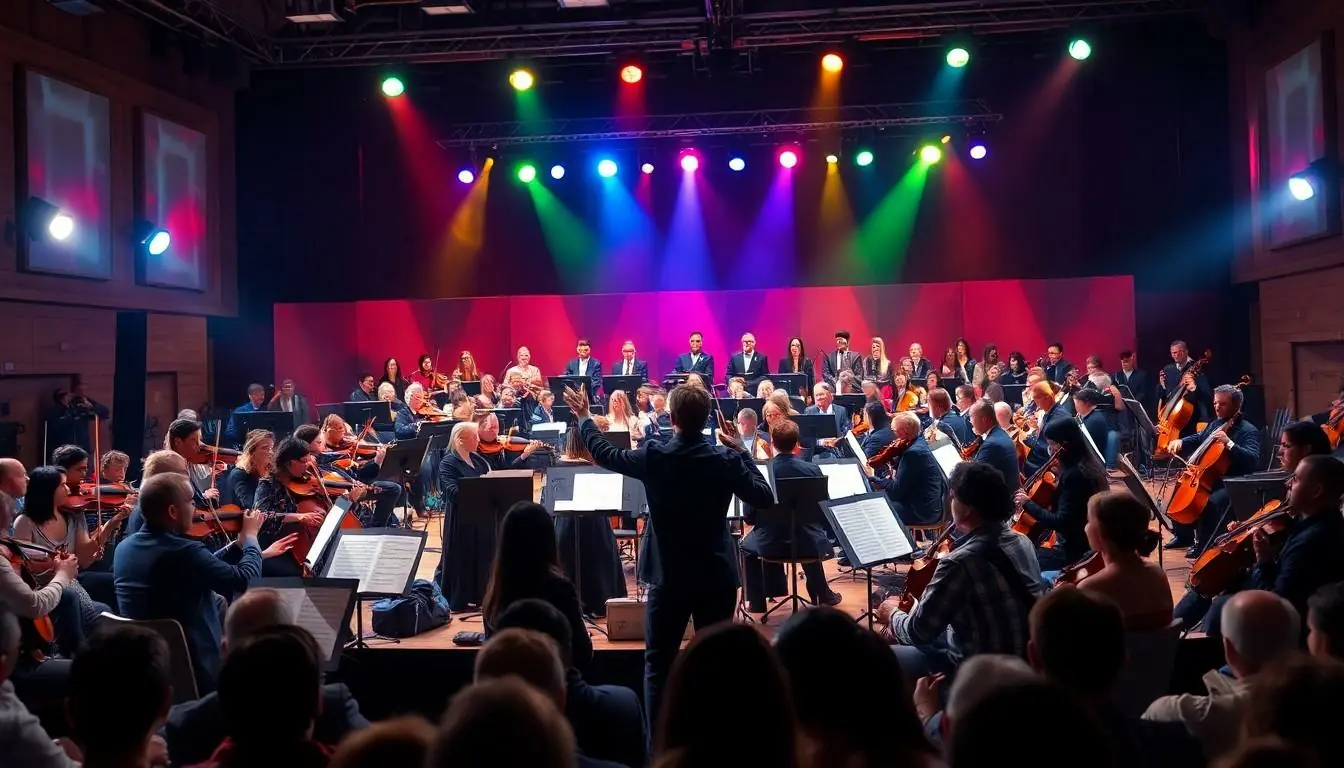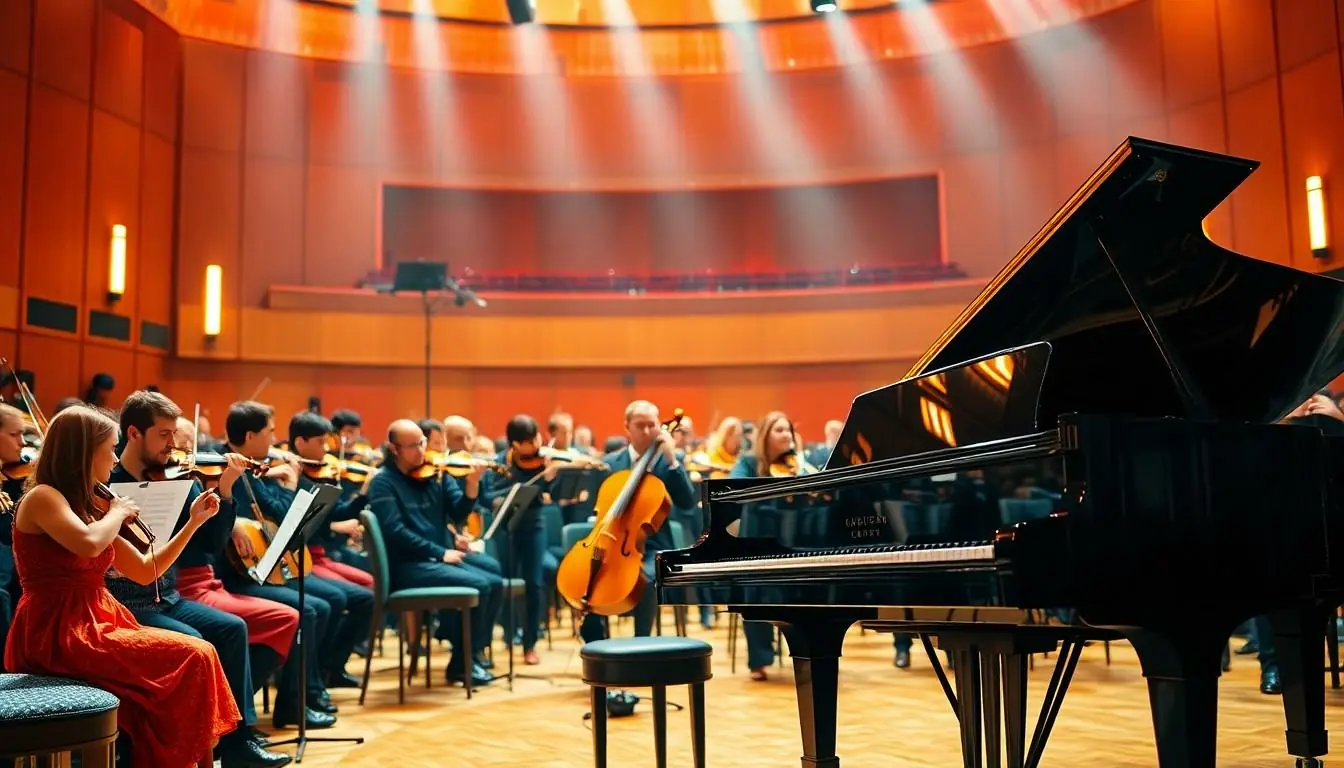Taylor Swift has taken the world by storm with her catchy pop anthems and heartfelt ballads, but what if she traded her guitar for a conductor’s baton? Imagine the enchanting melodies of her hits transformed into classical masterpieces. Yes, it’s time to explore the whimsical world where Swift’s lyrics meet the elegance of orchestras, creating a symphony that even the most discerning classical aficionados can’t resist.
Table of Contents
ToggleOverview of Taylor Swift’s Musical Journey
Taylor Swift’s career spans multiple genres, showcasing her versatility and artistry. Starting as a country music singer, she quickly gained recognition with her debut album, releasing Taylor Swift in 2006. This album featured relatable storytelling, resonating with a young audience and establishing her as a rising star.
Transitioning to pop music, Swift achieved unprecedented success with her fifth studio album, 1989, in 2014. This album marked a departure from her country roots, introducing synth-pop elements and catchy hooks that captivated global audiences. Chart-topping singles such as “Shake It Off” and “Blank Space” propelled her to new heights in the music industry.
Exploring deeper emotional themes, Swift’s albums like Reputation and Lover demonstrate a progression in lyrical maturity and musical complexity. The artist continuously evolves, experimenting with sound while maintaining her signature storytelling style. Collaborations with producers like Jack Antonoff and Aaron Dessner further expanded her musical palette.
In 2020, Swift surprised fans with Folklore and Evermore, showcasing a shift to indie-folk and alternative sounds. Both albums received critical acclaim for their introspective lyrics and intricate melodies. Incorporating diverse influences, Swift’s ability to adapt and grow ensures her music remains relevant and impactful.
Classical music enthusiasts can appreciate the potential for Taylor Swift’s songs to be reimagined in orchestral arrangements. The combination of her melodic sensibility with classical instrumentation may create new interpretations, enriching her music’s emotional depth. This innovative approach could attract a broader audience, merging the worlds of contemporary pop and classical music.
The Intersection of Pop and Classical Music

Taylor Swift’s music offers an intriguing foundation for classical interpretation. Her catchy melodies and rich storytelling can blend seamlessly with the intricacies of orchestral score.
Influences on Taylor Swift’s Style
Her musical journey is marked by various influences. Folk, pop, and country elements intertwine throughout her discography. Classic artists like Dolly Parton and Joni Mitchell shaped her narrative-driven songwriting approach. These influences reveal a deep appreciation for lyrical complexity and artistry. Swift’s ability to craft emotionally resonant songs creates connections with a wide audience. Her sound also shows traces of classical music through dramatic buildups and orchestral arrangements. Fans find enjoyment in songs that evoke strong emotions, reminiscent of classical themes.
Collaborations with Classical Musicians
Collaborations showcase Swift’s versatility and willingness to explore new sounds. She has worked with notable musicians across genres, helping bridge the gap between pop and classical. By collaborating with artists like orchestral arrangers and symphonies, she introduces her work to classical enthusiasts. These partnerships open new avenues for audiences to experience her music. Swift’s song “Blank Space,” for instance, has been reimagined in orchestral versions, highlighting adaptive potential. Such collaborations allow her energetic pop sound to resonate within classical frameworks, enriching both art forms.
Analysis of Taylor Swift’s Classical Covers
Taylor Swift’s classical covers showcase a unique blend of her modern sound with timeless orchestral arrangements. These interpretations highlight her versatile artistry and appeal to varied audiences.
Notable Classical Interpretations
“Blank Space” stands out among classical interpretations of Swift’s songs. This orchestral version takes her upbeat melody and transforms it into a hauntingly beautiful piece. “Love Story,” too, has been reimagined with lush string arrangements, amplifying its romantic narrative. Additionally, the symphonic adaptation of “All Too Well” captivates listeners with its emotional depth, allowing the lyrics to resonate in a new way. Each cover emphasizes the adaptability of her music within classical frameworks, inviting fans and classical audiences to appreciate her artistry deeply.
Audience Reception and Critique
Audience reception of Swift’s classical covers tends to be overwhelmingly positive. Fans express admiration for how the orchestral elements enhance her lyrical storytelling. Critics note the seamless transition, emphasizing the emotional connection her songs maintain even in different genres. Some reviewers highlight the innovative arrangements, praising the added layers of complexity. Others mention a growing interest among classical music listeners spurred by these reinterpretations. Overall, these covers foster a broader appreciation for Swift’s talent and the potential for cross-genre exploration.
The Impact of Classical Music on Taylor Swift’s Career
Classical music significantly influences Taylor Swift’s career trajectory. This influence manifests in various aspects of her songwriting and arrangement styles. Swift’s melodies often showcase a lyrical sophistication reminiscent of classical compositions.
Her collaborations with classical musicians highlight this connection further. Working with orchestral arrangers, she successfully melds pop sensibilities with traditional symphonic elements. These collaborations not only expand her musical repertoire but also introduce her work to new audiences.
Classical interpretations of her songs evoke strong responses. For instance, reimagined versions of “Blank Space” and “Love Story” illustrate how orchestral arrangements elevate her narratives. “All Too Well,” transformed with rich instrumentation, deepens the emotional impact of her lyrics, showcasing a seamless blend of genres.
Audience reception of these classical adaptations remains overwhelmingly positive. Listeners appreciate how orchestral elements enhance Swift’s storytelling. Critics highlight the innovative arrangements that maintain emotional connections across different styles.
This crossover appeal fosters greater enthusiasm for Swift’s artistry among classical music fans. The blending of her contemporary sound with classical sophistication allows for rich exploration and interchange between genres. Overall, the influence of classical music enriches Taylor Swift’s career, broadening her artistic landscape and audience reach.
Taylor Swift’s exploration of classical music offers a captivating glimpse into the potential fusion of genres. By reimagining her pop melodies through orchestral arrangements, she not only showcases her versatility but also invites a broader audience to appreciate her artistry. The emotional depth of her lyrics finds new life in classical interpretations, enriching the listening experience for both her fans and classical enthusiasts.
As the boundaries between pop and classical continue to blur, Swift’s collaborations and innovative covers demonstrate her commitment to artistic growth. This evolving relationship with classical music not only amplifies her narratives but also paves the way for exciting cross-genre explorations. The future looks bright as Swift continues to inspire and connect with diverse audiences through her unique musical journey.


